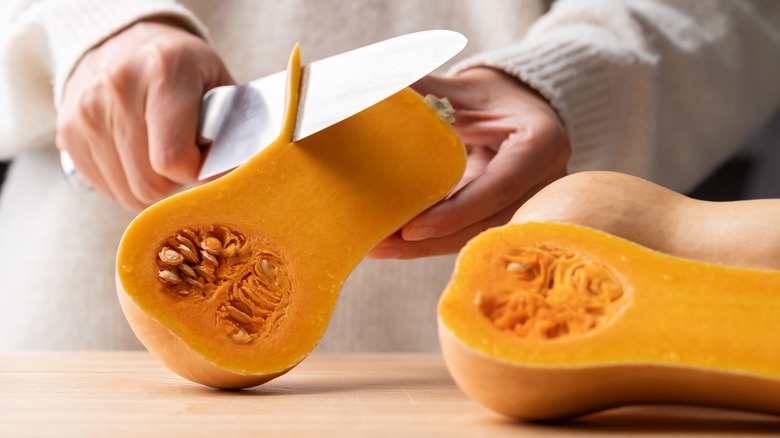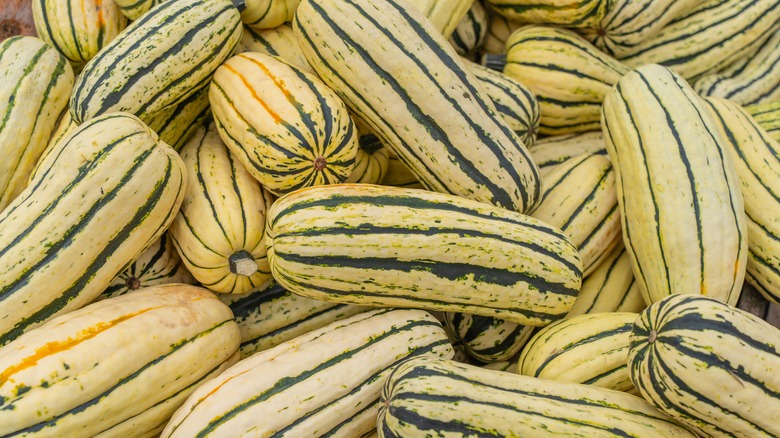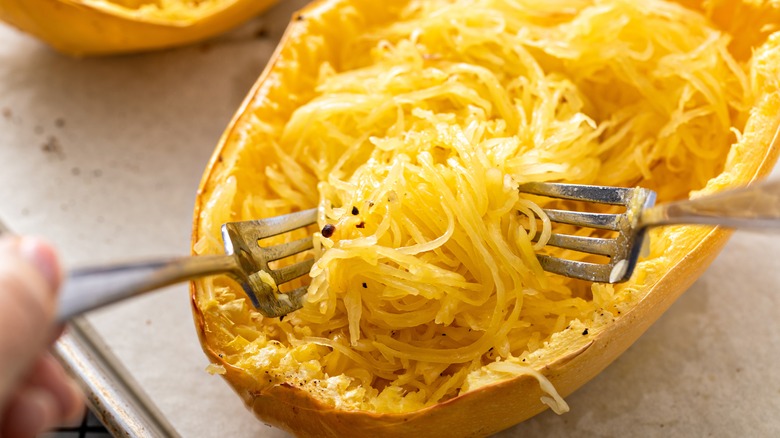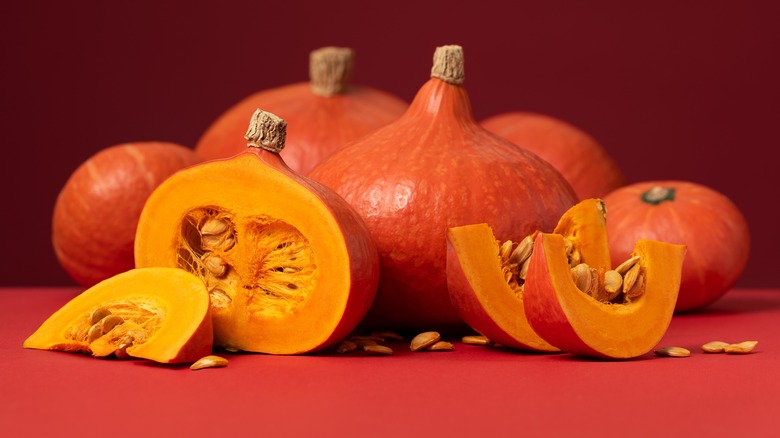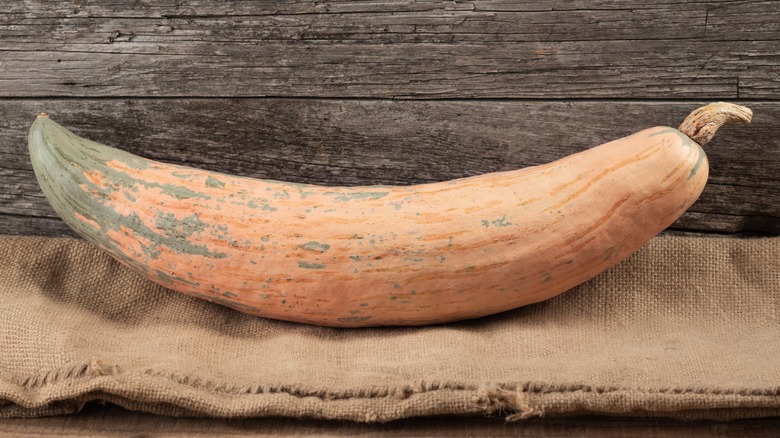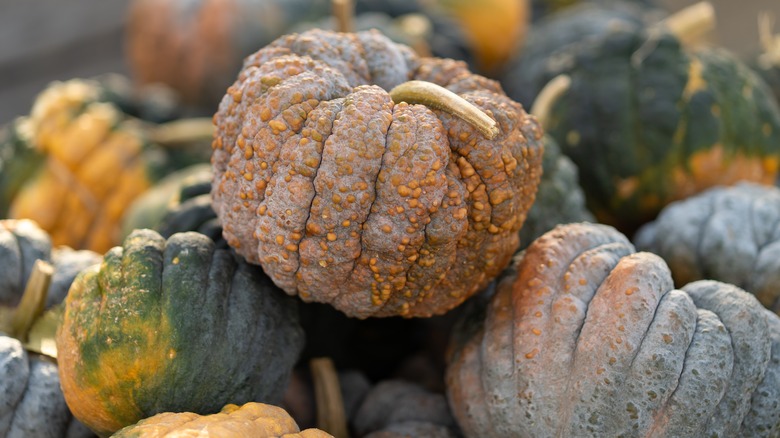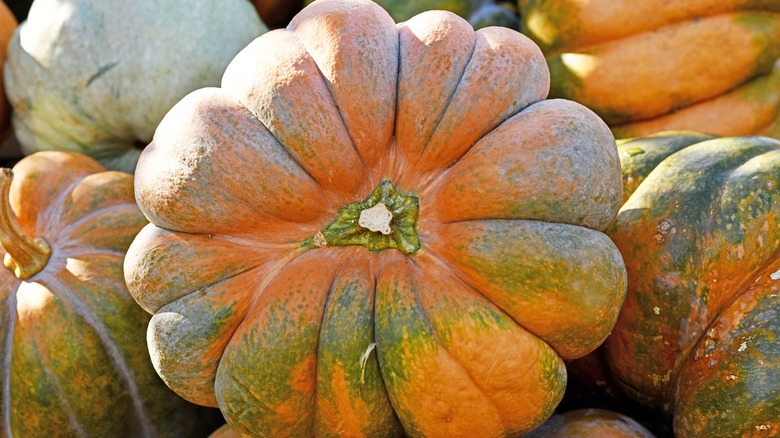10 Types Of Winter Squash (And What To Do With Them)
We may receive a commission on purchases made from links.
Fall always brings with it a glorious showcase of color, but it's not just the changing leaves that delights people. It's also the time of year when foodies rub their hands with glee at the smorgasbord of winter squashes. There are more than two dozen different types, coming in a range of shapes, sizes, and colors, with the majority falling into three main categories: Cucurbita maxima, Cucurbita moschata, and Cucurbita pepo.
There are a few things to be aware of when looking for the perfect winter squash at the grocery store or farmer's market. Weight is important — if it feels light, then chances are it's dried out and is past its best. The skin should be free of dark spots (which can suggest it's been left in the same position for a while and is a little old), and be firm to the touch. Soft skin is a no-no. Finally, check the stem for an indication of ripeness. If it's brown and grey, it's good to go.
There's so much texture and flavor to be had from winter squash, and the range is more versatile than you might think, so it's worth playing around with them. We turned to Sarah Grueneberg, chef and co-owner of Monteverde, Cheetie Kumar, chef and owner of Ajja, Kevin Grossi, culinary director at Big Red F Restaurants, and Cassidee Dabney, executive chef at The Barn at Blackberry Farm, for advice on types of winter squash and what to do with them.
Butternut
Fresh or frozen, home cooks in the United States love butternut squash, and it's easy to understand why. It's been around for thousands of years, and while nutritionists will talk about its fiber and vitamin A content, home cooks know it is versatile and tasty. Butternut squash works in so many recipes, from a rich, creamy soup to a hearty hash, but for Kevin Grossi, this winter squash can do even more. He likes to use it in salads and fillings but, when it comes to pies, while it's delicious in the sweet kind, Grossi also said, "you can challenge it with something savory."
What might surprise some home cooks is there's more than one type of butternut squash. Cheetie Kumar is a fan of the smaller varieties, which she said are easy to extract "big flavor" from. She name-checked the honey patch, butter baby, and honey nut squashes, and the latter is particularly interesting as it was developed by researchers at Cornell University.
These smaller butternut squashes are most commonly roasted, a process that caramelizes their natural sugars, boosting the taste, but it's not the only reason Kumar encouraged home cooks to give them a whirl. Alongside their concentrated flavor, she loves the color and texture of mini butternut squashes. "They're not too fibrous or too watery with a natural sweetness," she explained.
Delicata
Winter squashes come in a wide range of sizes, shapes, and colors, but one of the most attractive has to be the delicata. Longer and thinner than its round, bulbous bedfellows, it's actually part of the Cucurbita pepo family, which includes summer squashes like zucchini.
Also known as the peanut or sweet potato squash, delicata is notable for its stripy skin, which can be creamy white or pale yellow with green or orange stripes. The peel is also thinner than most winter squashes, something both Sarah Grueneberg and Kevin Grossi picked up on, making it easier to cut than some varieties. The cooked flesh is creamy and has a solid rather than stringy texture, making them ideal for roasting or stuffing, according to Grueneberg, after the seeds have been removed.
They're also delicious cut lengthways, sliced into thin arcs and pan-fried in a little olive oil and spices, but if you're looking for a healthier method, delicata squash stands up well to steaming and microwaving. Many winter squash contain the Cucurbitacin E toxin which makes their skins bitter and inedible, but this is another area where the delicata shines. Its skin is akin to that of the zucchini and delicious even when eaten raw.
Spaghetti
Some of the best fun we can have when cooking is playing around with recipe ingredients and finding out what happens. We know these baking ingredients will stand in beautifully for Greek yogurt, but finding a healthier version of a staple food can be more of a challenge. Luckily, in some cases, nature provides.
The fall crop of winter squashes includes the spaghetti variety; a smooth-skinned, oval vegetable that has a particularly clever trick up its sleeve. Slice the squash into rounds, add a grind or two of salt and a drizzle of olive oil, and pop in the oven for about a half hour. When they're cool, the flesh of the squash will separate out into mildly flavored, thin strands that are an ideal swap for noodles or the pasta in this amazing garlic prawn and tomatillo dish.
"How can you not love a squash that can be a great sub for one of my favorite pastas?!" said Sarah Grueneberg, but it's not just professional chefs who are spaghetti squash stans. These veggies are also beloved by health experts as a pasta stand-in, thanks to the low-carb, nutritional punch they pack.
Hubbard
Winter squashes come in a variety of forms, but the Hubbard is arguably one of the weirdest. It ranges in color from dark green, through blue-gray, to orange, can grow to hefty sizes, and gives off an alien pod vibe. Don't hold that against it, because the hubbard winter squash is delicious — if you can get past its extremely tough skin.
Depending where you buy yours, some stores or farmer's markets may pre-cut the squash for you. If you do decide to have a go at home, Kevin Grossi recommended using a cutting station that isn't too tall so you can get some weight behind the knife. It's also worth making sure your blades are good and sharp. Once you've cracked it open, you can do like Cassidee Dabney and peel the more manageable pieces. Sarah Grueneberg said she uses a "y" peeler similar to this one, but if you're roasting your squash, don't bother, just scoop out the soft flesh when it's cooked.
Although Cheeti Kumar admitted she will happily sidestep winter squashes that need peeling, calling some "downright dangerous," the effort is worth it for the hubbard variety. With a nutty, richly sweet flavor reminiscent of pumpkin, it's brilliant for both savory and sweet recipes. Swap the chicken in this four-ingredient rice dish for a delicious veggie version, or rustle up a mouthwatering pie – complete with this star addition.
Red kuri
Whether you go all out with your fall kitchen decor or prefer something more understated, a glorious red kuri winter squash never looks out of place. These vivid orange, slightly rough vegetables have their origins in Japan, where they were named after the chestnut, both because of its shape and its nutty flavor. Part of the Cucurbita maxima family, which includes the butternut and hubbard varieties, red kuri is a hit with two of our experts.
Sarah Grueneberg loves the gourd-like shape, as well as the easy-peel and its rich, deep orange flesh. "It has great sweetness and flavor," but isn't too starchy, she said. Kevin Grossi also loves the vibrant squash, which can be baked, roasted, and braised.
Red kuri has a mild, buttery flavor, and works brilliantly in stews, soups and curries, either as a purely veggie meal or alongside meats like chicken or pork. "I like to cut it into large wedges, bake it and smother it with queso and chorizo," said Grossi. If that doesn't float your boat, try dipping slices of red kuri in tempura, frying them, and serving with a shake of chili flakes for that extra little kick.
Candy roasters
We have Appalachia's Cherokee people to thank for this heirloom winter squash, sometimes known as pink banana or permelon, though there are tens of different varieties. It's a remarkable looking squash: Thin and growing up to 2 feet long, with colors varying from gray to pink. But its most remarkable trait is its staying power. Candy roasters can last up to six months if stored correctly (most prefer places that are 55 degrees Fahrenheit with 60% humidity) so they're potentially spring squashes, too.
They're Cassidee Dabney's favorite. "They are sweet, have a great texture for savory and sweet applications," she said. If you're able to hang on to your candy roaster squash for a few months, it's definitely worth exploring dessert options, as the squash gets sweeter over time. Purée it with warm spices like cinnamon, nutmeg, and cloves for a dream pie filling or spread it thickly over brioche or muffins.
If you prefer your squashes in savory dishes, candied roasters work amazingly with woody herbs like thyme, sage, and rosemary, so it's great in stews and casseroles. Alternatively, cube it, roast it with a slick of olive oil, and toss into a bowl of pasta for some of the world's best comfort food.
Black Futsu
They may not be the prettiest-looking winter squash but underestimate the Black Futsu at your peril. They have been grown in Japan for centuries and are beloved across Asia. At first glance, it can be difficult to understand why. Round and knobbly, the skin turns increasingly orange as it ripens and to the untrained eye can look diseased or moldy.
Just as all that glitters isn't gold, not all veggies that look gross are fit for the compost heap. Cut open a Black Futsu and its sweet, nutty flesh awaits. As for that ugly peel? It's easy to slice through and 100% edible. There are lots of ways to cook this winter squash too, including slicing it into thin wedges and roasting them like fries. Get a smaller one and it becomes the ideal vessel for all kinds of savory stuffings to make a delicious meal, and Kevin Grossi had a great recipe. "I like to take the entire squash and roast it whole very, very slowly. Let it turn into pudding inside on its own. Then carefully cut it open, season it with sea salt and hit it with an herb butter."
Jarrahdale
This hefty winter squash isn't just the perfect edible addition to your fall decorations, it's also good value for money, thanks to the amount of "meat" home cooks can get out of it. A New Zealand heirloom variety, the Jarrahdale is a cross between the hubbard squash and Cinderella pumpkin, hence that super-Halloween aesthetic. When the spooky season is done, there's plenty you can do with this delicious vegetable, too.
Sarah Grueneberg insisted it made an incredible pasta filling. "[It] reminds me of the Italian varieties used in Tortellini di Zucca pastas," she enthused. Gruneberg also encouraged home cooks to add a dash of green pumpkin seed oil or use the seeds as a garnish on savory dishes to amp up the flavor.
In Australia where the Jarrahdale is popular among home cooks, it's used in baking for scones, and often served as a side to a Sunday roast. Pair its nutty, sweet flesh with bacon and feta cheese for a savory brunch dish, but don't ignore the sweet options, either. Jarrahdale is relatively easy to purée, and its high sugar content makes it perfect for pies. You could even make it ahead of time for Thanksgiving alongside these two dishes.
Kabocha
Winter squash can be an acquired taste and not every variety is a hit with home cooks. It was the same with our experts when it came to the sweet kabocha squash. Popular in Japan, it's worth hanging onto for a few months before cooking, as the flavor and nutritional profile improve over time. Cheetie Kumar is a big fan, though she wouldn't hang around to eat hers.
"When it's really fresh and not super old, I love to shave and pickle the flesh. It's almost cucumber-like: Snappy, super delicious flavor." She recommended scouring farmer's markets to find them, but warned that quality levels can vary. "There's no one size fits all. Sometimes you need to play with your food. Roast, eat, try it out," she said.
Sarah Gruneberg was less enthusiastic about this starchier squash, though she acknowledged it was great for adding to purées or fillings that had been made with other winter squash varieties. For Kevin Grossi, texture was key with kabocha, advising that it can "go from firm to mush in a second." Unless it's specifically for a soup or going to be mashed, home cooks need to keep an eye on it, though gently cooked kabocha is great in a hash.
Musquée de Provence
A favorite of Kevin Grossi, the Musquée de Provence winter squash was brought to Europe from Central and South America, before making its way to the United States in 1899. It's hugely popular in France and often sold by the slice, as these green and orange, deeply grooved vegetables can grow to enormous sizes. Luckily, stored somewhere cool and dark, they will keep for months, so you can eat it at your leisure.
Each segment of the Musquée de Provence has dense, deeply orange flesh that can withstand robust cooking, including roasting, baking, sautéing, and grilling. It's perfect for dropping into hearty soups, stews, and casseroles, but its mild, slightly sweet flavor can quickly be overwhelmed. Puréed, it brings a creamy richness to baked goods, like muffins, cakes, and bread.
Interestingly, Musquée de Provence is one of the few winter squashes that can be eaten raw, so it's worth adding to a green or even a fruit salad, or diced as a cold side at a barbecue. Don't forget the seeds, either. Roast them and sprinkle with a little salt for a delicious snack.

